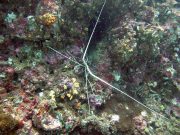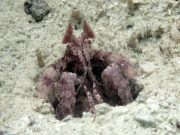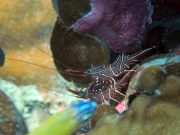Diving with Crabs, Lobster & Shrimp
Lanta Marine Life | Decapoda
Crabs, lobster & shrimp are Decapod crustaceans, ten-footed (five pairs of legs) scavenging marine animals which include many familiar groups, such as crabs, hermit crabs, lobsters, and shrimp. They are found everywhere when diving Koh Lanta.
Even though decapods are ten-footed animals, they can actually have as many as 38 appendages, arranged in one pair per body segment, though only 10 are considered 'legs'.
The macrurous (shrimplike) species, which can be as small as 1 cm, have elongated bodies with long abdomens, well-developed fan tails, and often long, slender legs.
The brachyurous (crablike) types, which in the case of spider crabs can have spans of almost 4 metres between their outstretched claws, have bodies that are flattened and laterally expanded, frequently with stout, short legs and reduced tail fans.
Diving with Crabs, Lobster & Shrimp around Koh Lanta
Scuba Diving & Snorkel Trips
If you'd love a chance to spot Crabs, Lobster & Shrimp on one of our daily high season diving trips from Koh Lanta then send us an email to info@diveandrelax.com.
Join our high season speedboat dive trips to some of Thailand's best dive sites and enjoy small groups, short journey times, with a focus on great personal service, safety and fun.
Not yet a certified diver? Learn to Scuba Dive on Koh Lanta with the 3 day SSI Open Water Diver course.
Book online to save 10% on dive trips and scuba courses on Koh Lanta.
Find Out More
Indo-Pacific Marine Life Guides
- Allen, G., Steene, R., Humann, P., DeLoach, N. (2003) Reef Fish Identification, Tropical Pacific. Jacksonville, FL., USA: New World Publications, Inc., ISBN 1-878348-36-1.
- Humann, P., DeLoach, N., (2010) Reef Creature Identification, Tropical Pacific. Jacksonville, FL., USA: New World Publications Inc., ISBN 978-1-878348-44-9
- Debelius, H. (2013) Indian Ocean Reef Guide. Frankfurt, Germany: IKAN - Unterwasserarchiv, ISBN 978-3-939767-52-7.
- Debelius, H. (2004) Nudibranchs and Sea Snails, Indo-Pacific Field Guide. Frankfurt, Germany: IKAN - Unterwasserarchiv, ISBN 3-925919-51-1
- Erhardt, H., Knop, D. (2015) Corals Indo-Pacific Field Guide. Frankfurt, Germany: IKAN - Unterwasserarchiv, ISBN 3-925919-69-4.
- Veron J.E.N., Stafford-Smith M.G., Turak E. and DeVantier L.M. (2016). Corals of the World









